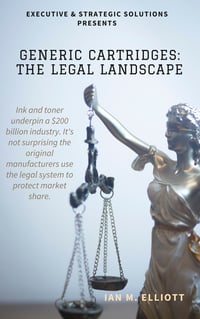The third dongle-gear patent dispute, initiated by Canon back on February 28th, 2018 in the forum of the International Trade Commission, named 49 respondents and asserted infringement of 9 patents (containing 193 claims of which 28 were independent). The dispute has now effectively been whittled down to 3 respondents (Aster Graphics, Print-Rite, and Ninestar)1, 7 patents, (2 have been withdrawn by Canon) and 21 claims, of which 10 are independent and 11 dependent.2
It is not unusual for the focus to narrow-in on specific patents and claims as a complaint progresses through the legal system, indeed, ITC ALJ's typically pressure complainants to reduce the number of claims in suit to lessen the burden on the court (and on the parties) of adjudicating the action.
The comparisons provided in the charts below are not intended to imply the position of the complainant, or that of the respondents, is either weaker or stronger as a result of the narrowing focus. This is just typical of the way intellectual property disputes usually progress.
Summary Charts - The Narrowing Focus of the Dispute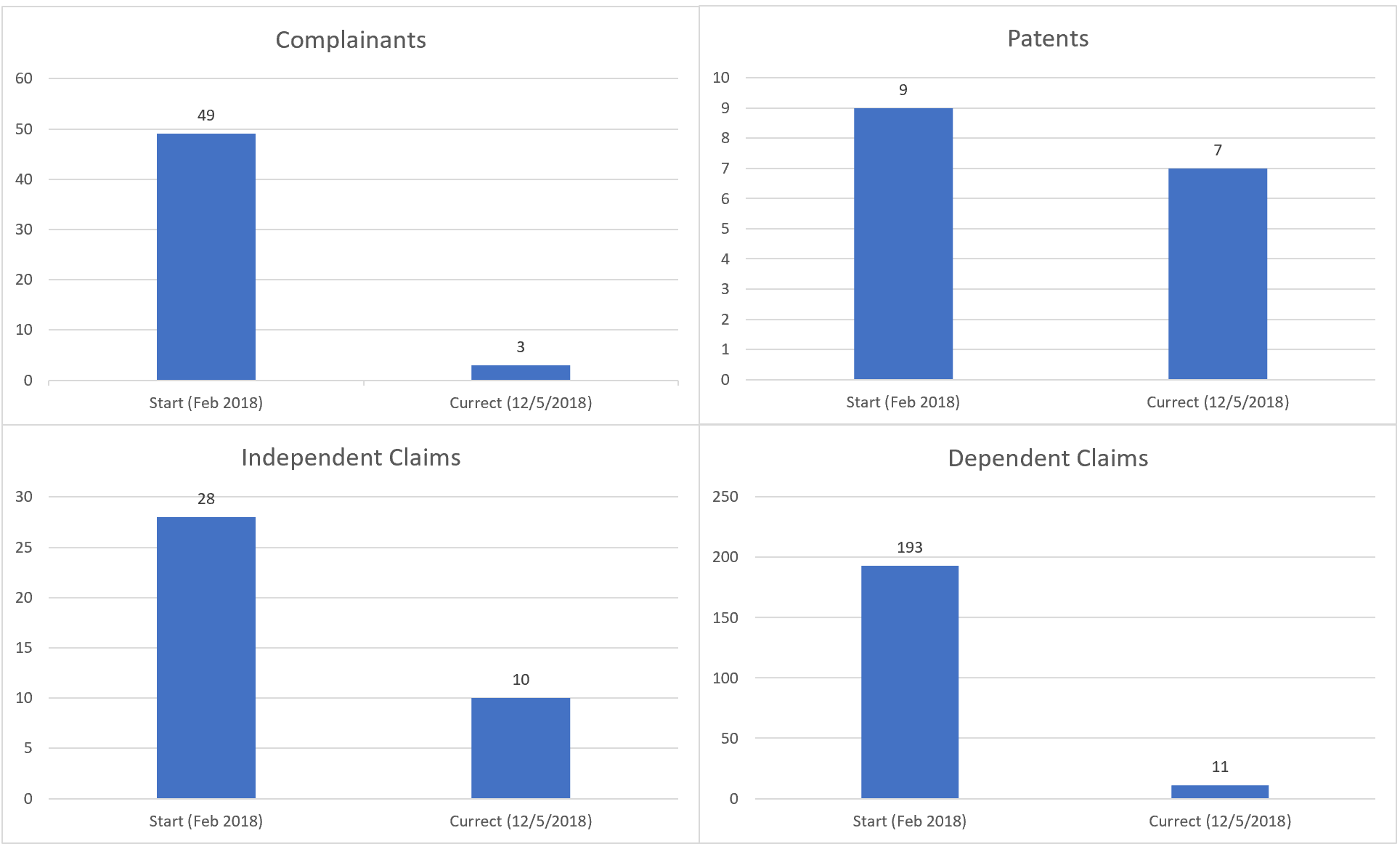
As we noted in a previously published article, a milestone occurred on August 31, 2018 when the Markman hearing took place. This event can be described as a sort of mini-trial during which each side was able to argue its case for claim construction - i.e. how each claim in the dispute should be legally interpreted.
What does the complaint boil down to?
There are five claim terms remaining that are disputed and, predictably, Canon has its interpretation of them and the respondents have theirs and they are different, which is why the dispute continues.
What was especially interesting however, was that the ITC staff attorney's 3 had (by this time) also developed their claim interpretations and, in their August 2018 Markman brief, it was clear these were substantially aligned with those of the respondents, and not with Canon.
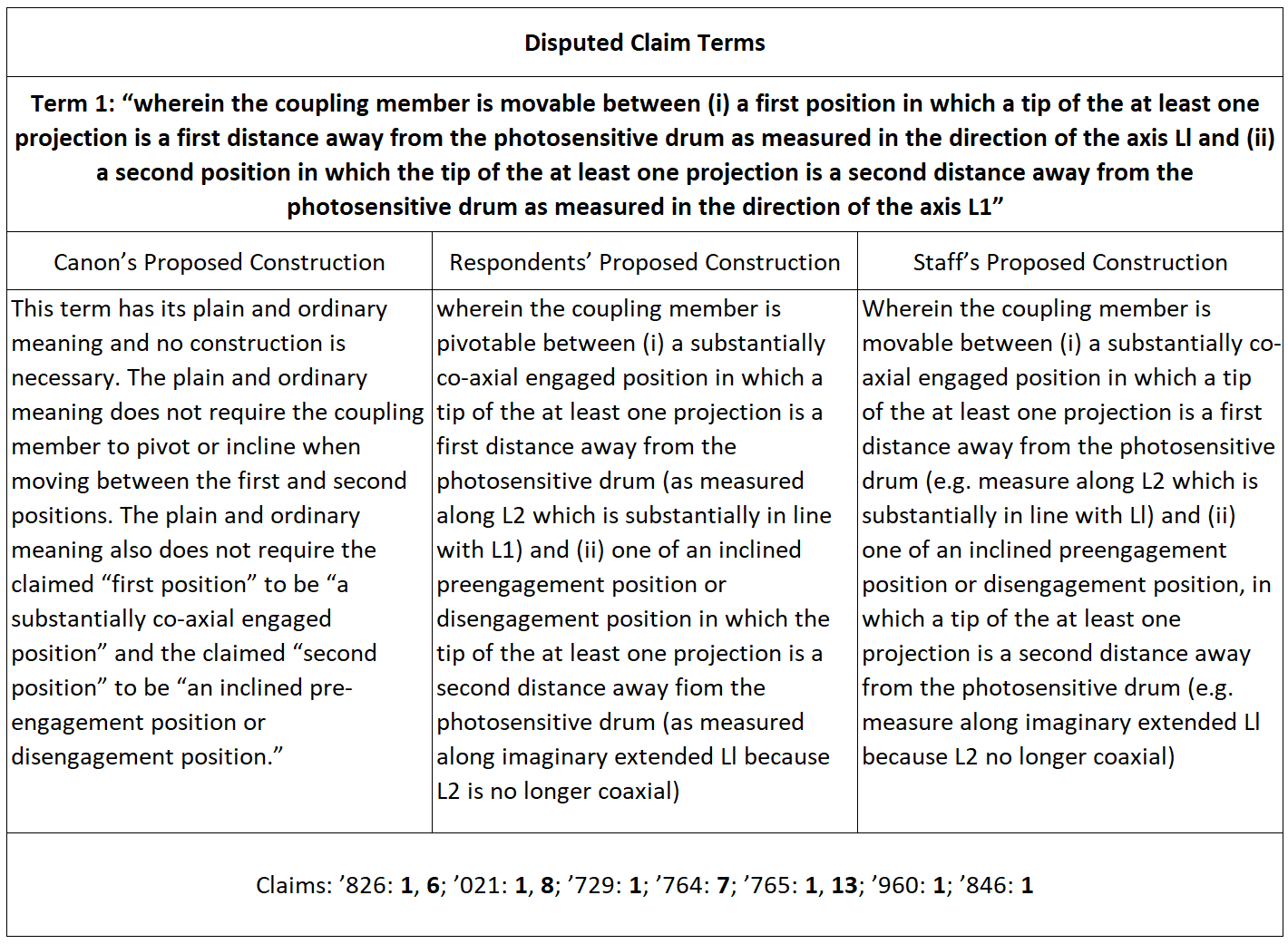
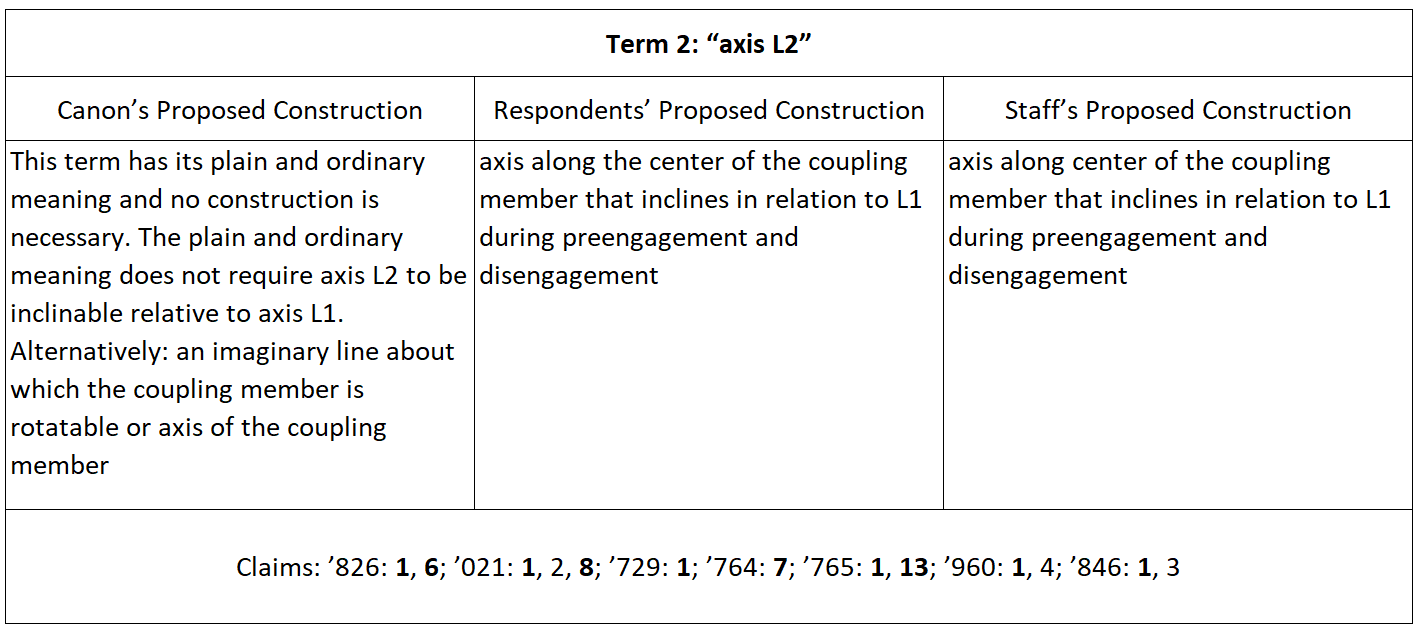
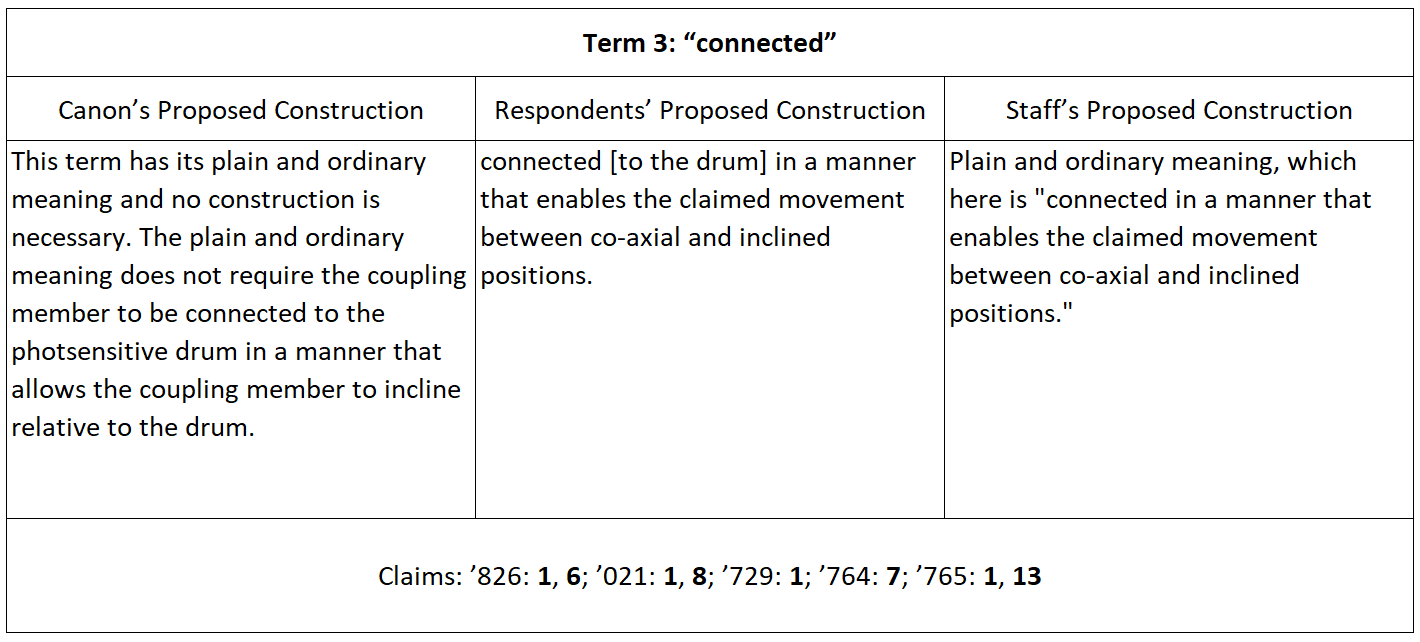
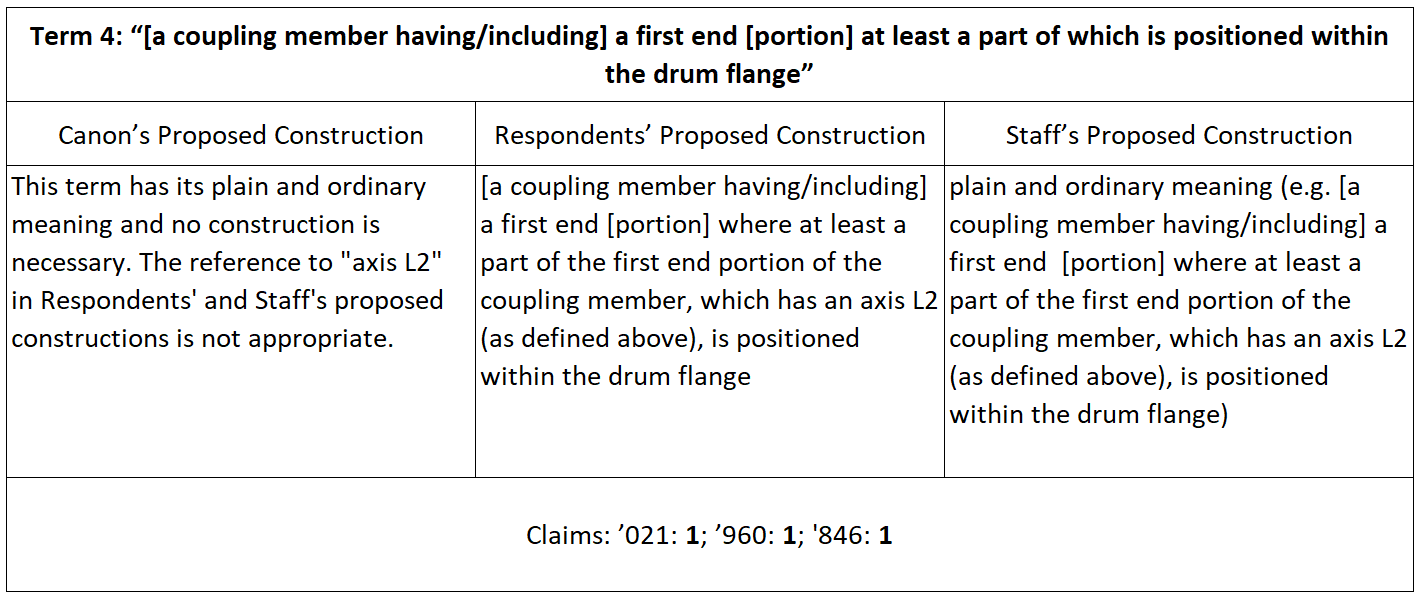
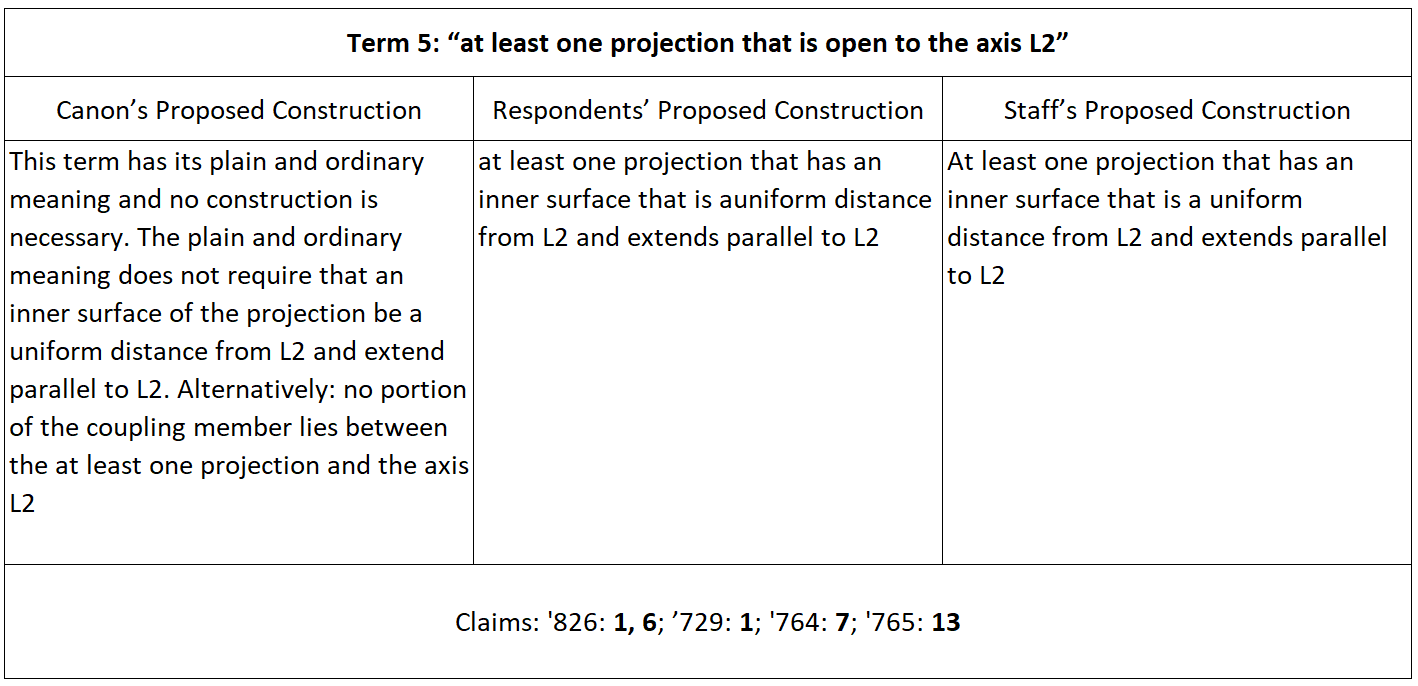
While each of the sides have now argued their case for claim construction, we still don't know which arguments presented at the Markman hearing had the greatest influence over ALJ Lord and which interpretations she may be leaning toward. As of this date (December 11, 2018) there has been no Markman hearing claim construction order issued and, indeed, there may never be one. 4
A Markman claim construction order (should one be issued) would determine if the three principle respondents in the investigation (Aster Graphics, Print-Rite, and Ninestar) are to be cleared of patent infringement prior to the trial.
Relevance of the five disputed claim terms to each of the primary respondents:
The following table shows how the five disputed claim terms relate to each of the three primary respondents in the investigation, and which claims the disputed terms are mentioned in within each of the remaining asserted patents.
The key takeaway should be that, for each of the respondents to be cleared of the patent infringement claims prior to trial, they each need any Markman ruling on claim interpretation to be in their (and the Staff attorney's) favor on all five disputed terms.
Although there are slight differences with regards to which claims apply to which respondent, and which patents are still applicable to the respective respondents, all five claim terms do still remain relevant to each respondent in some form or other.
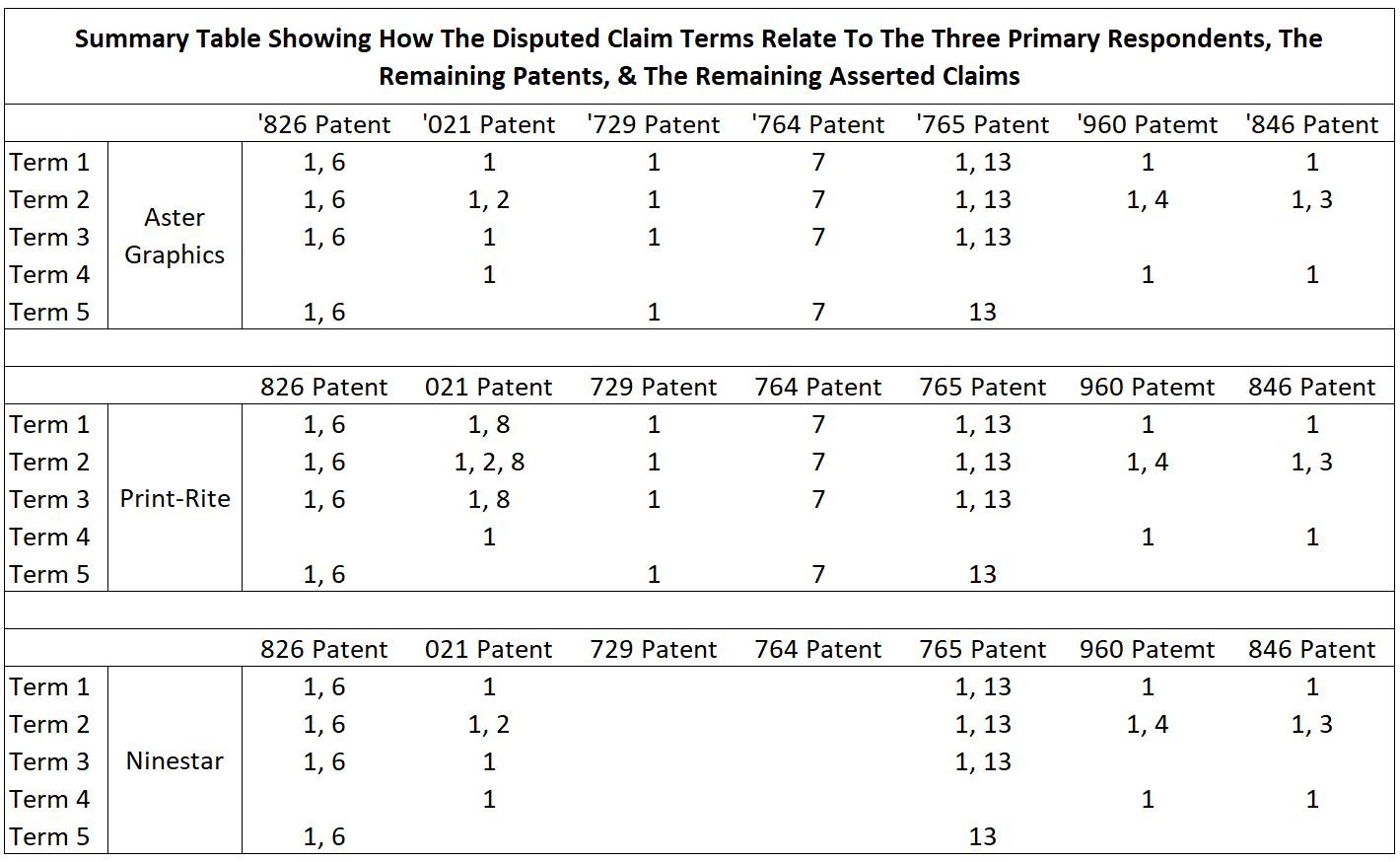
Another procedural milestone:
A further milestone was reached on November 28th, 2018 with the passing of the deadline for filing motions for summary determination. What's of interest here is that, a few days in advance of this deadline, (perhaps unsurprisingly) the three primary respondents, (Ninestar, Aster Graphics, and Print-Rite) all filed motions for summary determination of non-infringement, with Ninestar also filing a second motion for a summary determination of invalidity.
What are motions for summary determination designed to achieve?
With the respondents filing motions for summary determination, they are seeking to establish there is no infringement to answer for and they should be removed from the investigation in advance of the trial.
The problem the respondents face with the summary determination motions is that there's no obligation for ALJ Lord to issue a ruling on them, although, should she decide to do so, they would be decided based on the Markman hearing for claim construction.
Should a claim construction ruling take place, and should ALJ Lord adopt the respondents (or Staff attorney's) claim language interpretations, then there would no longer be a case for infringement of the remaining asserted patents (per the joint stipulation regarding infringement or non-infringement 5). Therefore, each of the three primary manufacturers (on who the importers, distributors, and resellers depend) would be dismissed from the investigation and their products effectively immunized.
However, in these circumstances, a Limited Exclusion Order could still issue against each of the non-participating respondents, particularly those that have previously defaulted.
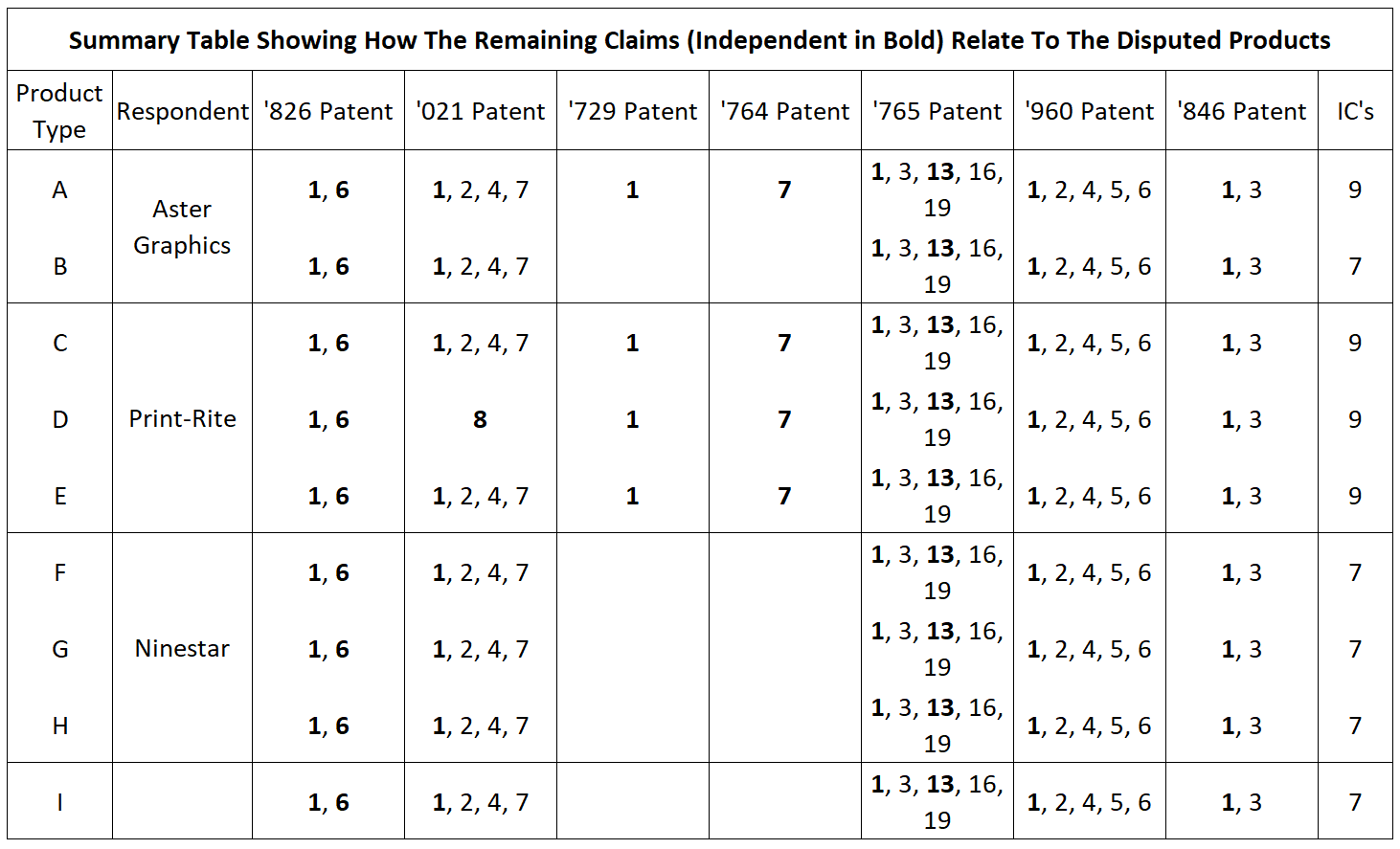
The argument for non-infringement:
It is important to understand what Canon has already agreed to in the joint stipulation:
If a Markman decision were to make clear that at least one disputed term of every claim asserted by Canon against the Accused Products of Aster (Type A or B), Print-Rite (Type C, D, or E), and Ninestar (Type F, G, or H), requires the claimed coupling member to be capable of pivoting or inclining with respect to the photosensitive drum, then the Accused Products would not infringe any of the claims asserted against them under that claim construction.
Conclusion:
Any claim construction ruling (should one be issued) that clearly (and fully) aligned itself with the position of the Respondents and the Staff attorney's on all five disputed claim terms, means there would be no infringement case for the respondents to answer to.
Any claim construction ruling that aligned itself with the position of Canon on at least one of the five disputed claim terms, means infringement would have been determined and, to avoid an outright loss, the respondents would then have to rely on arguments for invalidity of the asserted patents.
What is intriguing in this matter is that there is only one legal question remaining in the argument for infringement that bears on every one of the five disputed claim terms; that is, as to whether the "claimed coupling member [is] capable of pivoting or inclining."
This is intriguing because it raises the possibility that a single determination by ALJ Lord, ruling the coupling member must be capable of pivoting or inclining with respect to the photosensitive drum in order to infringe the asserted patents, would seem to be likely to decide the entire question of patent infringement in favor of the three participating respondents.
Of course, the opposite is true in that a single decision by ALJ Lord that the coupling member does not have to be capable of pivoting or inclining with respect to the photosensitive drum, would decide the patent infringement case in Canon's favor.
Invalidity Versus Infringement
In such an adverse ruling for the respondents, they would then be forced to switch tactics to argue invalidity of the asserted patents (per Ninestar's summary determination motion for invalidity) on the basis that the written descriptions, on which the patents rely, contain no mention that the coupling member does not have to be capable of pivoting or inclining.
In the event an invalidity argument comes into play, and should Ninestar ultimately prevail in its motion for summary determination of invalidity of the patents, then the entire litigation would be dismissed and no exclusion order would issue against any of the originally named 49 respondents, regardless of any defaults.
Could a Markman ruling end the dispute?
Unfortunately, regardless of the outcome of any potential Markman claim construction ruling, and despite the joint stipulation the parties have agreed to, they have not forfeited their right to appeal or to further argue their case in the district courts. In other words, an adverse Markman ruling against complainant or respondents and their options to appeal have been left open. Therefore, it is quite possible that, even in the event of a claim construction ruling being issued, the dispute would still not be fully resolved and would continue its way through the legal process.
How likely is it the Respondents are really closing in for the kill?
The fact that;
1. The Staff attorney's claim interpretation language is almost identical to that of the respondents must be a major confidence booster for the respondents because, although not binding on the ALJ, is usually persuasive.
2. There is a joint stipulation entered by complainant (Canon) and the respondents, that any claim construction ruling clearly stating the coupling member must be capable of pivoting or inclining with respect to the photosensitive drum, would result in non-infringement.
3. It appears a single decision by the ALJ on the claim construction would conclusively settle the argument on all five disputed claim terms.
4. Even if a claim construction order on the disputed terms was adverse to the respondents, thereby determining the patent infringement argument in favor of Canon, then it would immediately bring into play the argument for invalidity on which Ninestar has taken the lead with its motion for summary determination for invalidity.
In light of these points, a betting person would probably be thinking the respondents look more likely to prevail than the complainant. However, because there is no requirement for the ALJ to issue a claim construction order, or for any decision to be made on the four motions for summary determination, the likelihood is that the matter will not conclude early and will still proceed to trial at the end of January 2019. Should this prove to be the case, we will have to wait for the Initial Determination due on March 29, 2019 to learn which of the sides arguments have persuaded the ALJ.
To access our consolidated paper explaining the International Trade Commission's investigation into the third complaint in six years filed by Canon against aftermarket manufacturers, importers, distributors, and resellers of new-build cartridges, please click the image below.
Footnotes:
1 It is not the case that 46 of the 49 Respondents have been dismissed from the investigation. However, the three primary respondents have effectively assumed the case for many of the named respondents as a result of previously established patent indemnification agreements. As the "mega suppliers", these three Respondents have every incentive to litigate to the end if they believe they have a reasonable chance of prevailing. On the other hand, no single importer or reseller has much incentive to continue litigating, since its fate will be decided by the success of its supplier.
2 The reason we have delineated between independent and dependent claims is because, as a matter of law, a dependent claim cannot be infringed if the independent claim it is attached to is not infringed. Defendants focus on proving non-infringement of the independent claims knowing that must also resolve infringement on the dependent claims.
3 The Staff attorney at the ITC is a neutral third party, whose position is often persuasive to, but never binding on, the ALJ and the Commission.
4 There is no obligation for ALJ Lord to issue a Markman hearing order or to decide the four Motions for Summary Determination before trial. In part, because of the accelerated pace of a 337 investigation, ITC ALJ's often go to trial without deciding dispositive motions (such as these) before trial. Once the trial is over, the ALJ has about two months to consider the evidence presented both before, and during the trial before issuing an Initial Determination.
5 The Joint Stipulation was entered into on September 27, 2018 whereby the Parties agreed the five claim terms in dispute, and that if a controlling claim construction ruling made clear that at least one disputed term of every claim asserted against the Products requires the claimed coupling member to be capable of pivoting or inclining with respect to the photosensitive drum, then the Products would not infringe any of the claims asserted against them under that construction and vice versa.
To ensure you don't miss any of the important developments in this major story affecting products that underpin a $200 billion per year industry, please sign up for our blog using the button below.
About the author:
Ian Elliott has over 35 years' experience in the imaging supplies industry and, at prior places of employment, has faced direct involvement in OEM versus aftermarket patent litigation. Mr. Elliott is not a patent attorney, is not qualified to provide legal advice, and this article is not an attempt to provide any kind of legal advice. It represents no more than his views and opinions based on decades of relevant experience.


